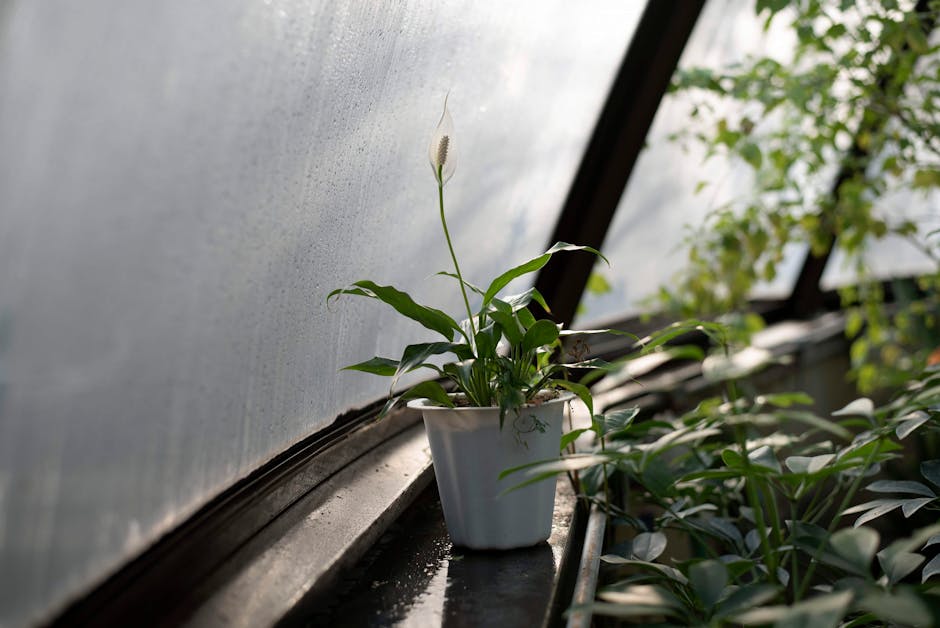Introduction
Complete Peace Lily Plant Care Guide
Ever noticed how a single plant can transform a dim corner of your home into a thriving green sanctuary? Peace lilies possess an almost magical ability to brighten indoor spaces while thriving in conditions where most plants would struggle. Whether you're a seasoned plant parent or just beginning your indoor gardening journey, mastering plant care for peace lily is surprisingly straightforward—and incredibly rewarding.
Peace lilies have earned their place as one of the most beloved houseplants for good reason. These elegant plants aren't just beautiful; they're also forgiving, adaptable, and remarkably low-maintenance. Unlike finicky varieties that demand constant attention, peace lilies actually communicate their needs through subtle visual cues, making them perfect for busy professionals and beginners alike.
In this comprehensive guide, we'll walk you through everything you need to know to keep your peace lily flourishing. You'll discover the essential characteristics that make these plants unique, learn why they stand out among other indoor plants, and gain practical insights into their care requirements. From understanding their botanical origins to mastering watering schedules and light preferences, you'll be equipped with the knowledge to help your peace lily thrive for years to come.
Understanding Peace Lily: Plant Profile and Characteristics
Peace lilies (Spathiphyllum wallisii) have become one of the most beloved indoor plants worldwide, gracing homes and offices with their elegant white flowers and glossy green foliage. Native to the tropical rainforests of Central America and Southeast Asia, these plants thrive in warm, humid environments—making them ideal for indoor cultivation. Their popularity stems from both aesthetic appeal and practical benefits, including air-purifying qualities that remove toxins like formaldehyde and benzene from indoor spaces.
What Defines a Peace Lily Plant
Peace lilies are evergreen perennials characterized by their distinctive white spathes (modified leaves) that resemble flowers, paired with true flowers clustered on a spadix. These plants typically grow 12-24 inches tall indoors, with some varieties reaching up to 3 feet. Their deep green, lance-shaped leaves create a lush appearance that complements any interior design style.
The plant's low-maintenance nature makes it perfect for beginners. Peace lilies communicate their needs clearly—drooping noticeably when thirsty, then perking up within hours after watering. This responsive behavior helps new plant parents learn proper plant care for peace lily practices quickly.
Why Peace Lilies Stand Out Among Indoor Plants
Beyond their visual appeal, peace lilies excel at adapting to various light conditions, tolerating everything from low indirect light to bright filtered sunlight. Unlike many houseplants requiring specific humidity levels, peace lilies thrive in standard indoor environments. They bloom consistently throughout the year with proper care, producing elegant white flowers that last several weeks.
Peace lilies also require minimal fertilization and rarely face serious pest problems, making them exceptionally forgiving plants. Their ability to bounce back from neglect, combined with their air-purifying properties, positions them as superior choices for busy plant parents seeking reliable indoor greenery.
Benefits of Growing Peace Lilies Indoors
Peace lilies offer homeowners multiple compelling reasons to incorporate them into their living spaces. Beyond their striking appearance, these plants deliver tangible health and lifestyle improvements that make them worth the minimal effort required for their care.
Air Quality Improvement and Health Benefits
Peace lilies actively purify your indoor air by removing harmful toxins like formaldehyde, benzene, and ammonia. NASA research confirms these plants filter airborne pollutants, making them ideal for bedrooms, offices, and living rooms where you spend significant time.
The air-purifying abilities of peace lilies contribute to better respiratory health and reduced allergen exposure. People with asthma or allergies often notice improvements after adding these plants to their homes. Simply placing one or two peace lilies in your bedroom can enhance air quality while you sleep, promoting deeper rest and better overall wellness.
Aesthetic and Decorative Advantages for Any Space
Peace lilies bring elegant, tropical sophistication to any room with their glossy green leaves and delicate white flowers. Their upright growth habit and compact size make them perfect for desks, shelves, or corner spaces without consuming valuable square footage.
The plant's versatility complements various interior design styles—from modern minimalist to bohemian eclectic. Their white blooms appear periodically throughout the year, adding dynamic visual interest without requiring seasonal replacements.
Low-Maintenance Lifestyle Benefits
Successful plant care for peace lily requires minimal effort, making them perfect for busy professionals and plant beginners. These forgiving plants tolerate irregular watering and variable light conditions, reducing stress about plant maintenance. Caring for a peace lily takes just minutes weekly, yet delivers psychological benefits associated with plant ownership—improved mood, reduced anxiety, and increased productivity in your home environment.
Essential Peace Lily Plant Care Requirements
Peace lilies thrive with consistent care that addresses their specific environmental needs. Mastering the fundamentals of plant care for peace lily ensures healthy growth and those signature white blooms year-round.
Optimal Watering Schedule and Soil Moisture Management
Water your peace lily when the top inch of soil feels dry to the touch, typically every 7-10 days. Overwatering causes root rot, the leading cause of peace lily decline, so err on the side of underwatering. Use room-temperature distilled or filtered water, as chlorine can damage the foliage.
Ensure your plant sits in well-draining soil containing peat moss, perlite, and orchid bark. This combination prevents water from pooling around roots while maintaining necessary moisture. Check soil moisture by inserting your finger 1-2 inches deep before watering.
Lighting Conditions and Ideal Placement Strategies
Position your peace lily in bright, indirect light away from direct sunlight, which scorches leaves. These plants tolerate low-light environments but produce fewer flowers with insufficient illumination. Place them near north or east-facing windows for optimal growth without harsh rays.
If leaves turn yellow, your plant likely receives too much direct sun. Conversely, leggy growth indicates insufficient light. Rotate your plant quarterly to promote even development.
Temperature, Humidity, and Fertilization Essentials
Maintain temperatures between 65-75°F, avoiding drafts and sudden temperature fluctuations. Peace lilies prefer humidity levels above 50%, so mist leaves weekly or place pots on pebble trays filled with water.
Feed your peace lily with diluted, balanced fertilizer every 4-6 weeks during growing seasons (spring and summer). Reduce feeding in fall and winter when growth naturally slows. Brown leaf tips often indicate fertilizer buildup, so flush soil monthly with distilled water to prevent salt accumulation.
Best Practices for Thriving Peace Lilies
Master advanced plant care for peace lily by implementing proactive maintenance strategies that prevent problems before they start. These techniques maximize your plant's health, longevity, and visual appeal while minimizing common issues.
Repotting, Pruning, and Seasonal Care Adjustments
Repot your peace lily every 12-18 months during spring using a pot only 1-2 inches larger in diameter. This prevents waterlogging while providing fresh soil rich in organic matter. Remove the plant gently, loosen the root ball, and transfer it to pre-moistened potting mix.
Prune yellow or brown leaves at their base using clean scissors to direct energy toward new growth. Remove flower spathes once they fade to encourage continuous blooming throughout the year. Adjust watering frequency seasonally—reduce it by 30-40% during winter when growth naturally slows.
Pest Prevention and Natural Disease Management
Inspect new plants and periodically check leaf undersides for spider mites, mealybugs, and scale insects. Spray affected areas with neem oil or insecticidal soap every 7-10 days until pests disappear. Maintain proper humidity levels (50-60%) through regular misting, which simultaneously prevents fungal issues and pest infestations.
Propagation Techniques for Growing New Plants
Propagate peace lilies through root division during repotting for the fastest results. Separate stems with attached roots and plant them in moist soil, maintaining warmth and humidity for 2-3 weeks until established. Water propagation offers an alternative method—place stem cuttings in filtered water, changing it every 3-4 days until roots develop within 4-6 weeks.
These strategies create ideal conditions for your peace lily to flourish year-round.
Common Peace Lily Problems and Solutions
Peace lilies are resilient houseplants, but they occasionally signal distress through visible symptoms. Learning to identify and address these issues quickly keeps your plant thriving. This troubleshooting guide covers the most frequent problems and their proven remedies.
Diagnosing Leaf Discoloration and Wilting Issues
Yellowing leaves typically indicate overwatering or poor drainage. Check your soil moisture by inserting your finger two inches deep—it should feel slightly moist, not soggy. If waterlogged, repot your peace lily into fresh, well-draining soil and reduce watering frequency to once weekly.
Brown leaf tips signal low humidity or mineral buildup from tap water. Mist your plant daily or place it on a pebble tray filled with water to increase ambient moisture. Switch to distilled water to prevent salt accumulation, which stresses the foliage.
Wilting despite moist soil suggests root rot or inadequate light. Move your plant to a bright, indirect location and inspect roots for dark, mushy tissue. Trim affected roots with sterile scissors and repot immediately.
Addressing Root Rot, Pests, and Environmental Stress
Root rot develops in consistently wet conditions and requires immediate intervention. Remove the plant from its pot, cut away blackened roots, and repot in dry soil. Allow the top inch to dry between waterings moving forward.
Spider mites and mealybugs commonly infest peace lilies. Spray affected plants with neem oil or insecticidal soap every seven days until pests disappear. Isolate infested plants to prevent spreading to nearby houseplants.
Environmental stress from cold drafts or heating vents causes leaf damage. Position your peace lily away from air conditioning, heaters, and open windows. Maintain temperatures between 65-80°F for optimal growth and vibrant foliage.
Conclusion
Caring for a peace lily doesn't require a green thumb or complicated techniques—it simply demands consistency and attention to a few fundamental principles. Throughout this guide, we've explored how these elegant plants thrive when given the right conditions, from indirect light and proper watering to humidity management and occasional feeding. The beauty of plant care for peace lily lies in its forgiving nature; these resilient plants actually communicate their needs through wilting leaves and browning tips, making them ideal for both beginners and experienced gardeners.
The key takeaways are straightforward: maintain moderate indirect light, water when the top inch of soil feels dry, provide humidity through misting or pebble trays, and fertilize sparingly during growing seasons. Perhaps most importantly, remember that peace lilies are incredibly adaptable—they'll adjust to your home's unique environment while rewarding your efforts with lush foliage and stunning white blooms.
Beyond their aesthetic appeal, peace lilies offer remarkable air-purifying benefits, making them valuable additions to any living space. They transform neglected corners into vibrant focal points while simultaneously improving your indoor air quality.
Ready to bring peace and greenery into your home? Start by assessing your available space and light conditions, then acquire a young peace lily to begin your plant parent journey. Don't be discouraged by initial setbacks; every experienced plant enthusiast has struggled with their first specimen. With the knowledge you've gained here, you're fully equipped to nurture a thriving peace lily that will flourish for years to come. Your green sanctuary awaits.

